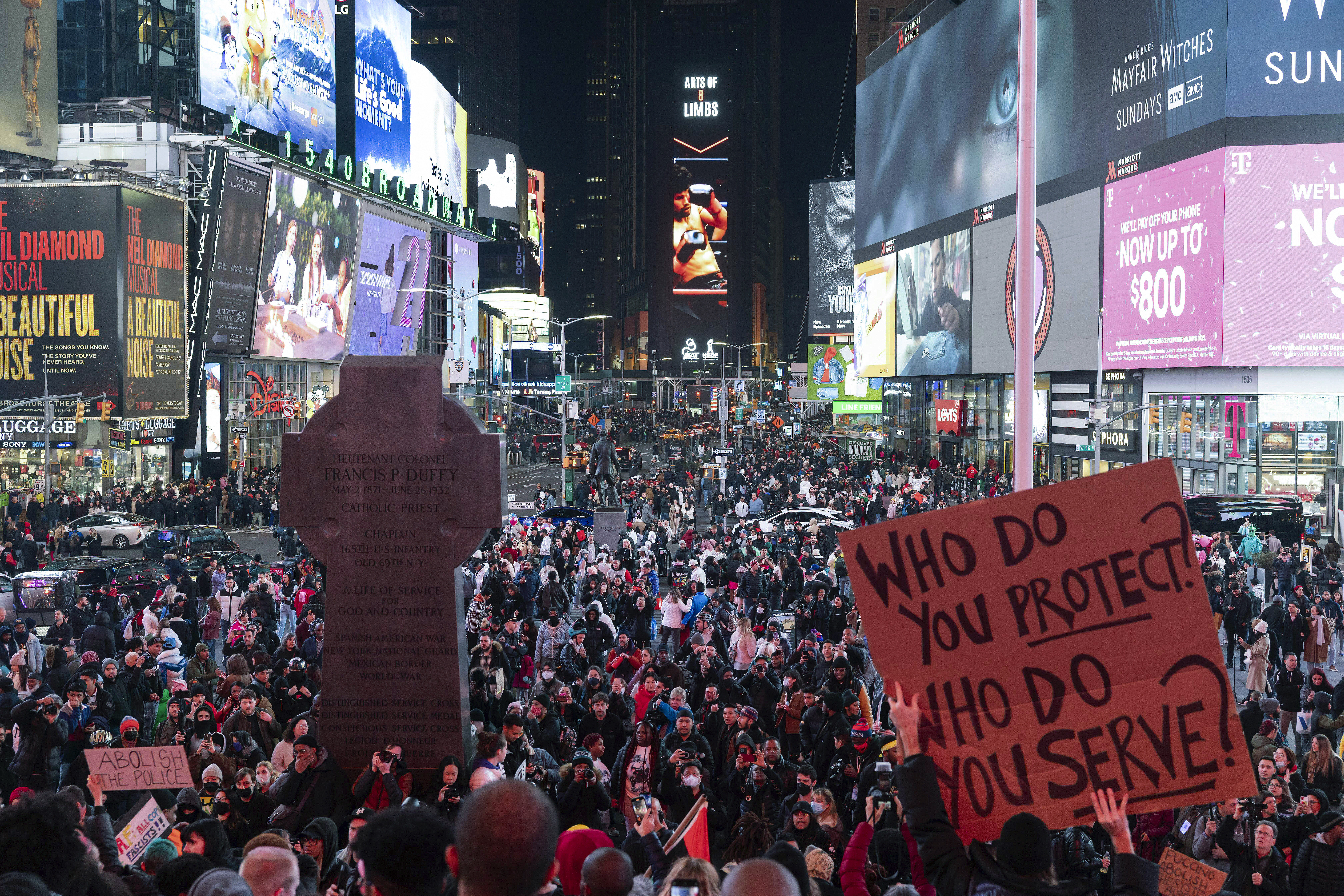Opinion | The Medics Are Also to Blame for Tyre Nichols’ Death
EMS technicians need to be held accountable for failing to adequately treat victims of police violence.


The medics involved in the death of Tyre Nichols are culpable and need to be criminally charged.
With the release of video showing the brutal beating of the 29-year-old Black man in Memphis, the world was stunned at the unchecked rage and seeming joy with which police assaulted him. It’s no surprise that we tend to gravitate toward the images and videos of active violence perpetrated by law enforcement, but their visceral impact can create a sort of tunnel vision. We often don’t see the pernicious and insidious passive violence perpetrated by professional bystanders.
In nearly every police-involved-murder and abuse of force, there is a silent party on the scene whose actions typically go unnoticed: the rescue and medical responders who fail to treat these victims properly. Emergency medical services personnel have, very rarely, faced legal consequences in the past, so charging those who betrayed Tyre Nichols would not be unprecedented. But the bottom line is that all public safety professionals with a duty to act must be held accountable, and that will require a fundamental shift for our society.
As a former paramedic of 25 years, an EMS educator and author, and a former law enforcement officer, I see these cases through a different lens than most. When looking at these videos, as difficult as it is, I try to look past the violence and assess the actions of the first responders that did not intercede to prevent the act from occurring.
The case of Tyre Nichols is rife with instances of both EMS and police failing to attempt to save the dying man’s life. The video shows several figures off to the side for long stretches, not actively engaging — simply watching, meandering and occasionally talking with the victim who is clearly in distress.
The video also shows EMS workers failing to render what we call the “standard of care” for trauma patients. Based on national standards and Tennessee state EMS protocols, this consists of, at minimum, assessing the victim’s airway, breathing and vital signs, and in the setting of head trauma, immobilizing the victim’s spine and neck and applying oxygen to prevent brain damage. In recent days, two Memphis Fire Department EMTs on the scene were released of their duty pending an agency investigation. It has not been confirmed if these were the two medics seen in the video.
In at least two critical areas, the EMS workers fell short.
First, both National EMS and Tennessee EMS protocols prescribe the application of supplemental oxygen as the first treatment for head trauma. It’s the simplest and yet most critical step to providing aid and does not require changing the position of the patient or removing any restraints (like handcuffs). When faced with significant head trauma, blood flow to the brain becomes severely restricted from swelling. Untreated, the condition worsens as the injured brain is starved of precious oxygen leading to cerebral hypoxia (oxygen deprivation to the brain).
Second, in emergency medicine there are two important benchmarks that are taught to every EMS technician. The first is the “platinum 10 mins,” which is how long it should take from the arrival of EMS to the rapid transport of a critically injured patient to ensure optimal survivability. The second is the “golden hour,” originating from Baltimore’s famous Shock Trauma Center, which suggests a higher likelihood of survival when proper pre-hospital care, rapid transport and definitive emergency care in the emergency department or operating room is rendered within 60 mins of sustaining the injury.
Based on the released footage, the medics on the scene of Tyre Nichols’ assault appeared to squander what could have amounted to precious time for the victim to receive care at a trauma center. While the definitive cause of death is pending the final forensic examination (autopsy) and toxicology reports, the combination of delay in delivering care, specifically oxygen, and the delay in transport may have contributed significantly to the death of this young man.
Unfortunately, this case is by no means unique. The paramedics who responded to George Floyd made the ill-advised decision to “load and go,” as opposed to assessing and treating him on the scene, which was needed considering his state. EMTs and medics responding to Eric Garner, the Staten Island man killed by NYPD officers in 2014, also did very little when they arrived. The four EMS technicians failed to bring any oxygen or resuscitation equipment to his side, while one EMT failed to even recognize that he was deceased and continued to mill around while talking to him for over two minutes. No criminal charges were filed against these workers, and they faced only administrative discipline. Similarly, in 2016, Dallas paramedics injected a restrained Tony Timpa with a sedative and simply watched him expire without providing any basic care. Those medics never suffered legal consequences and received only administrative discipline for their actions.
EMS personnel are rarely charged for their malpractice when improperly assessing and treating victims in police custody. There have been several exceptions, however, including in 2017 when medics failed to treat and transport William Marshall, a prisoner in a Michigan jail who swallowed cocaine and subsequently died. In 2021, two medics were charged in contributing to the 2019 death of Elijah McClain, a 23-year old Black man in Aurora, Colorado, after the medics injected him with a powerful sedative to chemically restrain him. Earlier this month we saw the arrest and indictment of two Illinois EMTs on first-degree murder charges for the mistreatment and subsequent death of a 35-year-old patient after police were called.
Most EMS workers engage in heroic work. They have suffered greatly during the Covid-19 pandemic and have been rightly recognized for their bravery, skill and compassion. Just a few weeks ago, medics were widely hailed as heroes after saving the life of Buffalo Bills player Damar Hamlin on live national television.
So why do so many EMS workers fail to properly treat police-involved trauma cases, yet are competent and capable of treating just about any other form of major trauma?
The answer is a complex mixture of culture, apathy, racism and cognitive bias. These public servants patrol the very same “mean” streets as their law enforcement partners. And they do so, often arriving before or without police, without the tools law enforcement possesses to protect themselves. EMS is one of the most dangerous occupations in the country according to numerous government and academic reports. While many EMS fatalities and injuries are attributed to automobile accidents and roadside crashes, some are injuries sustained by targeted violence toward these workers. In 2017, a New York City fire department EMT’s ambulance was carjacked in the Bronx and the driver then ran over the EMT, killing her. Last year, a veteran fire department EMS lieutenant was stabbed and killed on a busy Queens street in broad daylight. Numerous EMS workers have been shot or stabbed across the country by those who are intoxicated, mentally ill or involved in violent domestic disputes.
As such, EMS has come to rely too heavily on their partners in law enforcement to be at their side and protect them. Because it is such a dangerous profession, EMS workers are disinclined to break with their local police by doing anything that is contrary to what the officers want on the scene. It is in this environment that the “blue wall of silence” can extend from police to the EMS.
While the last few years has been a period of reflection, reform and in some cases reckoning for law enforcement nationwide, EMS workers have largely not addressed their own roles.
To effect true change will require a broad cultural shift within EMS, but policymakers can also do much to promote reform, including:
Move EMS out of the National Highway Traffic Safety Administration
Because of its origins in preventing deaths on the road, EMS has since its inception been placed in this little-known federal agency. To get the national-level oversight it deserves, EMS should be housed in the Department of Health and Human Services or the Department of Homeland Security, where it can help respond to major incidents like terrorist attacks, active shooter scenes, natural disasters and pandemics.
Train EMS technicians in the clinical signs, symptoms and trauma inflicted by police use of force and create specific EMS protocols for treatment of patients who are in police custody.
Responding to police use of force is not part of national or state EMS standards, training or protocols. Technicians should be trained in proper positioning of retrained patients, compression of airway and treatment of patients who have been tased. The use of chemical restraints (sedatives) in the setting of in-custody patients should receive a national-level review.
Include police use of force training and scenarios in EMS education.
Most progressive police departments now require training for the deescalation of the use of force and train members in how to deter, deescalate and intercede in acts of excessive force by other officers. EMS personnel need to be trained so they can understand the scenarios involved with use of force and excessive force that they may witness first-hand or be called to respond to afterward. Teaching similar deescalation techniques to EMS would benefit all present on the scene.
Pass into law requirements for EMS to not withhold care or treatment from individuals who are in police custody.
The first rule of medicine is “do no harm” but that does not mean do “nothing.” Emergency medical professionals are taught to serve as patient advocates throughout the continuum of care, particularly when the patient cannot speak or defend themselves. EMS workers need to be empowered to do their jobs without fear of retribution from their law enforcement colleagues.
Change the culture and power dynamic in which EMS workers feel as if they must be silent, complacent or party to police abuses in order to assure their own continued protection on the job.
State and local jurisdictions need to work harder to prevent violence against EMS personnel. At the same time, law enforcement agencies need to project an expectation that EMS workers are obligated to report abuses they witness. There should be no quid pro quo exchanging police protection for EMS complacency.
Hold EMS personnel liable for failure to report police violence.
EMS workers in most states are “mandatory reporters” for child or elder abuse and can be held criminally and civilly liable for failure to report such abuses. Individuals under custody, just like prison inmates, are also a population vulnerable to abuse. Hold EMS personnel to the same standards as law enforcement that stand idly and watch their colleagues abuse citizens. This will send a definitive message to the EMS community that it can no longer stand off camera, hands-in-pockets committing acts of passive aggression.
The death of Tyre Nichols forces us to confront yet another moment where both those who have sworn to protect and those who have sworn to treat appear to have breached their duty. As this, and future, cases receive scrutiny, lawmakers, prosecutors, government officials and the public need to widen their aperture to consider the inactions of those on the periphery. While EMS workers are not necessarily committing the choking, kicking or pummeling themselves, they are in a position to attempt to stop law enforcement from taking a life.
EMS was created in the wake of the seminal 1966 white paper entitled “Accidental Death and Disability: The Neglected Disease of Modern Society.” Now that we have a modern EMS system in this country, we need it to stop neglecting certain segments of our society.












